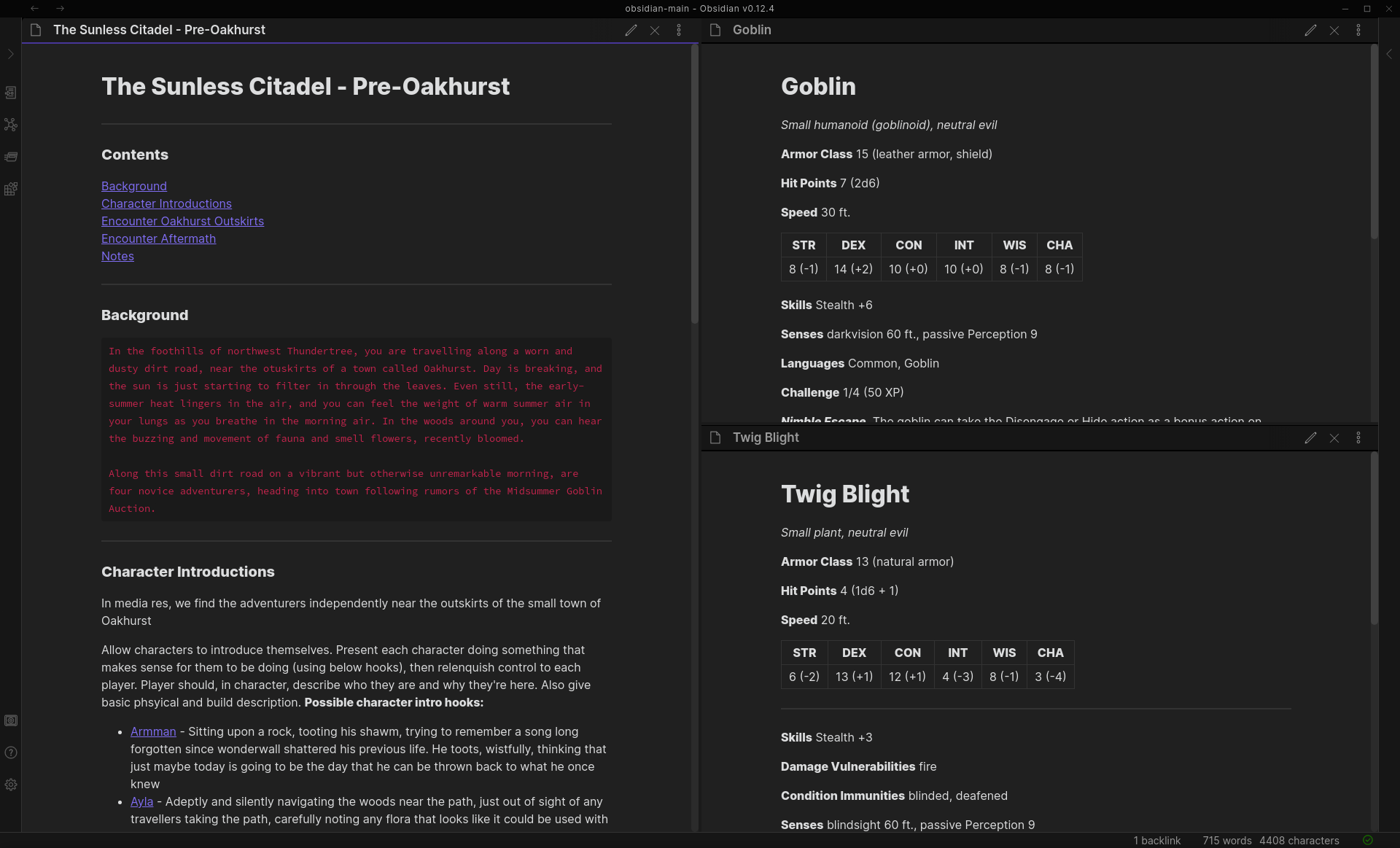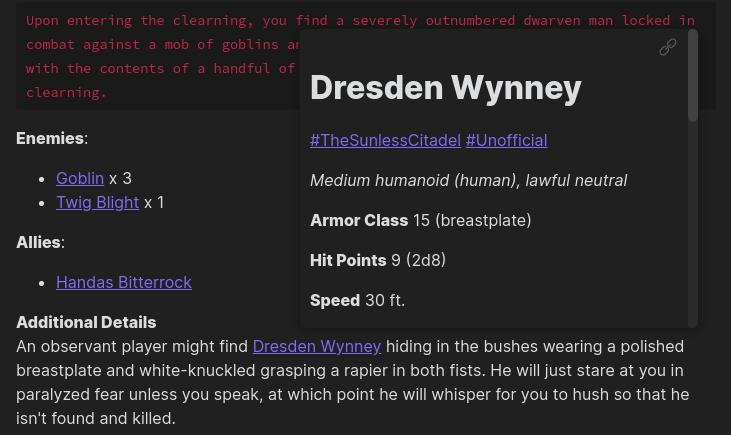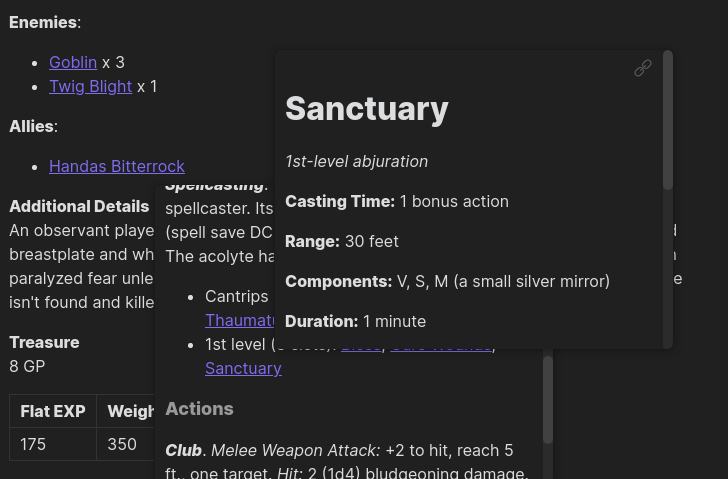Let's Talk About Obsidian and D&D
I’ll start with two disclaimers:
- I’ve been avoiding development work in my free time. It be like that.
- I hate to sound like a shill, and can never be sure of the line between blatant advertisement and enthusiasm
So, now that that’s out of the way… I’ve been playing a lot of Dungeons & Dragons. Or, at least, a lot for someone with a social limit of one activity per week. Outside of my regular campaign and a steady drumbeat of one-shots, I’ve picked up DM’ing with some close friends who had expressed interest in playing before, but didn’t have anyone to run a game for them. I’m not super comfortable with it yet, but the vibe is super casual because I’m the most experienced player, and also because the group that is playing is basically the dream-team for “I have no idea what the hell I’m doing and I need your patience while I figure it out.”
I have also recently transitioned to using Obsidian as a markdown editor (from Typora), because Obsidian has vim controls and I’m deep enough into vim-brainrot that it’s difficult to write large chunks of text without vim support1.
I’m not proud of swapping for the reasons I did, but I don’t regret it. Obsidian is significantly more feature-full than Typora, to the degree that it’s silly to even imply that they solve the same set of problems. I primarily used Typora for writing technical notes and design documents in my previous position, and any personal note-taking that happened through Typora was merely for the convenience of writing in markdown. Obsidian, on the other hand, is not so much a markdown editor, as it is a markdown-enabled knowledge base creator that allows you to connect your ideas together in text in a way that I find to be particularly intuitive.
So, because D&D requires a fair amount of mental organization, and the campaign I’m running is over the internet (and will remain so even post-COVID), I did some poking around to find out if anyone had tips for how to organize a D&D game using Obisidan. As it turns out, yes. I won’t go into too much detail here, because the linked blog post explains much better than I can why Obsidian is an ideal environment for running a game, BUT I did want to put some thoughts here, now that I have run (and planned) a few sessions using Michael Barret’s 5e SRD obsidian-formatted reference.
Quick note before continuing: I’m running the Sunless Citadel for my group currently, and screenshots contain mild early-game spoilers, if that’s something that you’d like to avoid.
Multiplexing
Obsidian can be used in a single-pane edit mode, which is the default to this when opening new files. That said, the real power comes in when using the environment as a multiplexer, which is one of the main bullet-point features of Obsidian. Splitting your screen into as many panes as you need in the moment allows the editor to function as a standard DM-screen.

This works particularly well for me, because the hotkey settings are robust enough to allow me to mimic my tmux pane-swapping commands in the editor, meaning that I can continue mouseless editing and navigation as though I’m in my standard vim/tmux work environment.
Templates
Another really nice feature of Obsidian is the ability to define a template folder, which is accessible with the Templates plugin2. The template feature itself isn’t anything earth-shattering– you create a basic markdown file with a layout that you think you’ll use often, and then you can insert that template into any file and edit it to suit your immediate needs.
I’m almost certainly not using these guys to their full potential, but I’m already seeing a lot of benefit in being able to save a consistent format for certain concepts.

This is also really nice for expanding on the SRD content provided in the references linked above. This has made adding new monsters and NPCs a breeze, and I can rest easy knowing that all of the info I need is present, because the whole process is fill-in-the-blank rather than remembering what’s needed for each individual templated-object.
Tooltips
Obsidian’s major feature (the most important of the aforementioned “bullet-point features”) is its internal linking mechanisms. This is what elevates the editor from “markdown editor” to “knowledge base builder.” In addition to standard in-document linking via anchor tags (like one would use to generate a table of contents), there is also support for linking together two documents using quick easy-to-type shorthand. The document-linking has a lot of super cool features involved with it that are beyond the scope of this post, but I highly recommend you read up on them if you’re considering trying out the editor.
One of the features document linking is a tooltip preview window, which allows you to peek at what the contents of a file are before opening that file in a new pane. Full disclosure: this is why we’re here. The built-in tooltips are 100% what sold this for me as an ideal-for-me game-running platform. This doesn’t sound like it’s a game-changer, but it basically turns your DM board into a Crusader Kings game. You can hover over link and get a full, well-formatted blurb explaining what exactly is going on in its destination.
It works when linking two documents together, for a quick reference for an NPC, location, or monster

It’s also useful for linking to somewhere else in the same document. I’ve been using this for keeping track of the table of contents for each session, and also as a way of tracking minor NPCs who are not worth writing out a full article for (basically, anyone who doesn’t need a stat block)

And, as if it could get any better, the tooltips also stack! While this isn’t ideal for casual browsing, I’ve found it to be very useful when running an encounter with a spellcaster.

I realize it’s a little overwhelming, but being able to navigate my notes quickly and efficiently in the middle of a session has made it a lot easier to transition from player to game master, and these tooltips are a perfect safety net for me. I switched to using Obsidian because it provided a better document editing experience for me, but editing is only half of the story, and the tooltips make document reading an absolute joy.
So, uh, in conclusion
There are a lot of other things that I like about Obsidian, but these are the major highlights for what I am guessing is a fairly niche (but certainly not unique) use-case. I’ve been gushing over this setup for a few weeks now and haven’t had an audience for it (the main person who would care is one of my players 😬), so I just wanted to take some time to gush more formally and express gratitude for the above-linked reference files, and hopefully to help point anyone else in the right direction.
I’ll be back when I’m back, stay safe, stay cool ✌️
Resources:
- Obsidian
- Running Tabletop Games with Obsidian
- Obsidian 5e SRD
- Markdown 5e SRD (the obsidian reference is based on this markdown conversion)